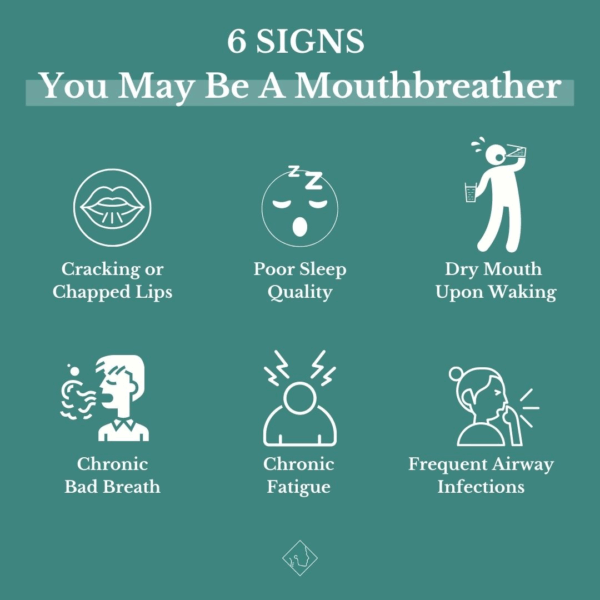How is Mouth breathing impacting your life?
25th November, 2025Breathing is the foundation of life; it fuels our cells, energises our bodies, and keeps every system functioning.
Breathing should be easy, effortless and silent, allowing our tummy to expand as our diaphragm pushes down, making space for our lungs to fill during inhalation and fall naturally as the diaphragm rises during exhalation.
However, for many individuals, this natural pattern is disrupted. Instead, they rely on upper chest breathing or habitual mouth breathing, which is typically fast, shallow, and loud. This style of breathing is associated with the body’s stress response, activating the sympathetic nervous system often referred to as the Fight or Flight.
This is one of the many effects habitual mouth breathing has on our bodies. In this article I uncover its impact on oxygenation, nervous system regulation, and overall health.
Why is Nasal breathing so important?
One of the most important reasons to breathe through the nose is the production of nitric oxide (NO). This is a powerful gas that boosts oxygen absorption in the lungs and improves blood flow. Typically NO is at its highest concentration during breath holding. Nasal breathing also filters and humidifies air, helping protect the body from allergens and pathogens.
But habitual mouth breathing bypasses all of this.
And the consequences aren’t just about dry mouth, lips or snoring. Mouth breathing especially in a developing child can have some drastic impacts.
Why do people often mouth breathe?
When the airway is compromised or nasal breathing feels restricted, the body naturally defaults to mouth breathing especially during sleep or times of stress. Over time, this pattern can become habitual, even when nasal breathing is possible. Common reasons for mouth breathing include:
- Tongue tie or low tongue posture
- Deviated septum
- Chronic nasal congestion due to allergies, or frequent colds
- Enlarged tonsils reducing space in the airway, especially in children
- Narrow or high-arched palate
- Sinusitis
- Poor myofascial or craniofacial development
Why It Matters

Mouth breathing is not just a cosmetic or dental concern. It affects oxygenation, brain development, immune function, and quality of sleep all of which are crucial during early life stages. Early identification and intervention can help prevent long-term issues with learning, behavior, and health.
Breathing well is a primal function, but it’s one that many children have lost. Reclaiming it through myofunctional therapy to retrain breathing and oral posture, chiropractic to support nervous system regulation and muscle tone, speech pathology and nutritional support can make a powerful difference.
The iron connection
Chronic mouth breathing tends to lower oxygen saturation in the blood, making the body work harder to oxygenate tissues. When the body senses low oxygen levels, it compensates by increasing the production of red blood cells, which is needed to carry oxygen to tissues. This as a result increases the demand for iron, as iron is the core component of hemoglobin, the oxygen carrying molecule in red blood cells. Over time, as the iron stores are used, iron deficiency can occur or may unmask an existing iron deficiency.
So how can I find out if my child is low in iron?
It’s important not to supplement with iron based on symptoms alone. Many of the signs of low iron such as fatigue, irritability, or poor concentration can also occur when iron levels are too high in a condition called hemochromatosis. Giving iron unnecessarily may do more harm than good. So this is why it is so
It’s important not to supplement with iron based on symptoms alone. Signs such as fatigue, irritability, or difficulty concentrating can also appear when iron levels are too high, as seen in a condition called hemochromatosis. In these cases, giving iron unnecessarily can do more harm than good. That’s why proper testing is essential.
The easiest way to determine your child’s iron status is through a blood test. This can be arranged through your GP, or a Chiropractor.
Symptoms of Mouth Breathing
Cognitive & Emotional
- Brain fog/difficulty concentrating
- Poor short-term & working memory
- Daytime fatigue or sleepiness
- Anxiety
- Irritability & frequent mood swings
- Hyperactivity or Impulsive behaviours (ADD or ADHD like symptoms)
- Emotional outbursts
Sleep-Related
- Snoring or noisy breathing during sleep
- Sleep apnea
- Frequent night waking and restlessness
- Nightmares or night terrors
- Bedwetting (beyond the age of 5)
- Waking with a dry mouth, sore throat or headache
- Waking up tired
Oral and Facial Development
- Long, narrow face
- Narrow upper jaw and crowded teeth
- Retruded or recessed jaw position
- Open mouth at rest, poor lip seal
- Drooling during day or sleep
- Dark circles under eyes
- Small or underdeveloped nostrils
Respiratory & ENT issues
- Chronic nasal congestion or blocked nose
- Frequent sinus or tonsil stones
- Persistent sore throat
- Bad breath
- Frequent ear infections
- Wheezing, asthma like symptoms
Functional & Muscular
- Tongue thrust when swallowing
- Difficulty chewing or swallowing properly
- Speech delays or articulation problems (e.g. lisps)
- Poor body posture and core stability
- Low muscle tone
- Tongue tie or lip tie affecting function
Other Health & Developmental Signs
- Iron deficiency or anaemia
- ‘Tired but wired’ behaviour in children
- Frequent colds, coughs or illnesses
- Digestive issues (constipation, reflux, poor appetite)
- Delayed milestones or slowed growth
- Reduced endurance or stamina
- Headaches or TMJ pain
If you suspect that you or your child may be showing signs of mouth breathing, don’t wait. Early intervention can make a world of difference. Reach out to our team at Beyond Self to learn how we can support you or your child on the path to better breathing, health, and overall wellbeing.
Healthy breathing is not just a goal, it’s the foundation to thrive.
share this entry








